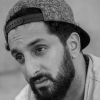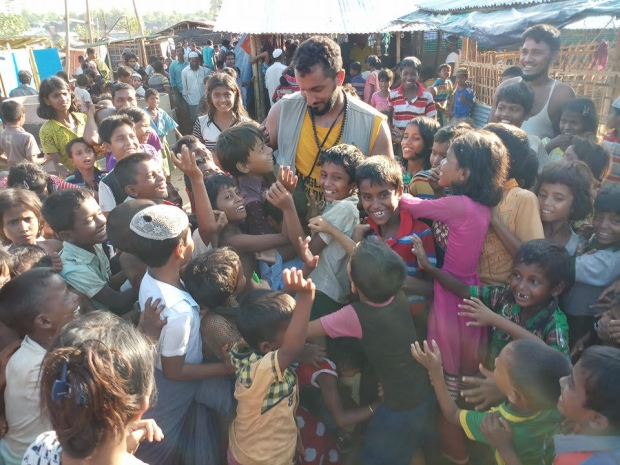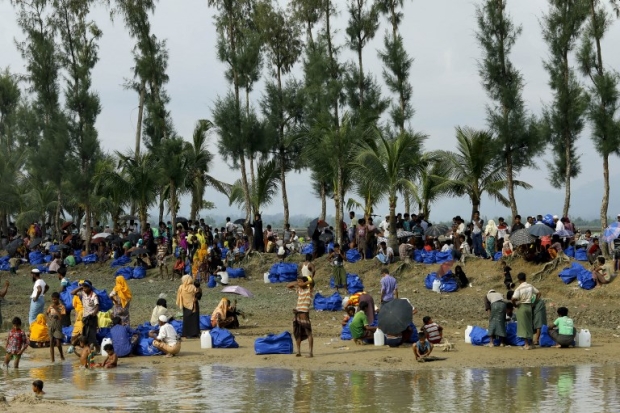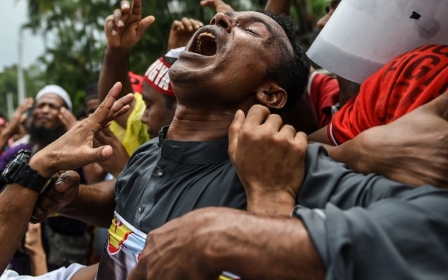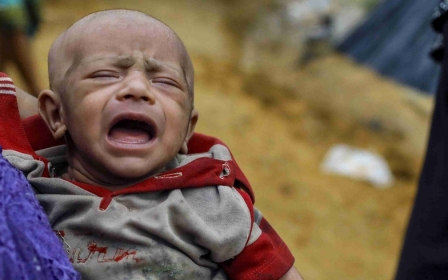Heart of darkness: Face to face with the Rohingya crisis

My first trip out to the Myanmar-Bangladesh border was in December 2016, when my team and I delivered emergency relief to the Rohingya refugees in the coastal town of Cox’s Bazar.
I have worked as an aid worker in some of the world’s most dangerous and violent conflict zones, but I was shocked to witness the distressing conditions in which these refugees lived. It was as if they did not exist, forced to live in squalor and hidden slums, away from the public eye. Native Rohingya were made to feel like criminals, as if their identity was something shameful.
During the first week of Ramadan in 2017, we returned to Cox’s Bazar in the midst of monsoon season. To make matters worse, Cyclone Mora, which ended up doing more than $1bn of damage across large parts of southern Asia, hit at the same time. Much of the aid we distributed was destroyed in the cyclone, along with the shelters that housed thousands of Rohingya refugees. We had to start from scratch.
Turning point
I was conducting interviews for case studies of people who had recently fled the brutal genocide in Myanmar, when I heard something that marked a turning point in my life.
It was frantic. Women and babies screamed for help, while others had sustained injuries from burns, machete strikes and bullets
I spoke with two Rohingya sisters, 15 and 17, who approached us and wanted to pour their hearts out. The 15-year-old looked me dead in the eyes and told me how she was tied up and systematically raped by 15 soldiers, while her parents and siblings were made to watch. She was then made to witness the brutal murders of her mother, father and younger brother.
Her sister then explained how she, too, was raped by a soldier, and just three weeks before escaping Bangladesh, she gave birth to a baby boy because of the assault.
This was no longer a standard humanitarian aid mission, but a personal quest for me to raise my voice for the Rohingya refugees - the victims of a vicious ethnic cleansing.
In a tuk-tuk, we travelled for four hours to Teknaf, at the southern tip of mainland Bangladesh. We hopped on a fishing boat, crossing to an island just two kilometres from Myanmar. We had to remain silent and keep all the lights off, so as not to be spotted by Myanmarese soldiers.
Flow of refugees
We arrived at the remote island and walked to the other side, where I saw boat after boat of Rohingya refugees crossing the narrow river. I stood there in awe, counting at least 10 boats within five minutes of my arrival. Over the water, I saw military outposts shining lights across the river to ensure that the only flow of people was towards Bangladesh, and not back to Myanmar.
On the sandy river banks, we helped families, livestock and injured people off the boats. It was frantic. Women and babies screamed for help, while others had sustained injuries from burns, machete strikes and bullets.
As we approached the border, we could no longer see trees or green fields, but just a sea of bodies in the sun, drained from the long journey
Most had not eaten in a week, and they told us that more than 90,000 people remained in the woods, waiting for their chance to escape. Days later, my organisation, the Human Relief Foundation, set up a hot food kitchen to cook more than 1,000 meals a day for the newly arrived refugees.
On the third day of the kitchen’s operations, a friend called to tell me that 20,000 people had just arrived at one of the land crossings and were stranded with no food or water in the blistering sun. We instantly drove down to the Anjuman Para area, where the crossing is located, and started making our way towards the military zone where the refugees were waiting to be processed by Bangladeshi authorities.
Nearer to the crossing point, I came across a young mother who had just given birth before crossing over. The baby was still covered in blood, and the mother looked like she was about to pass out.
Sleeping on roadsides
The number of people was estimated at 20,000, but our supplies would not even cover five percent of them. We started distributing to young children, pregnant women, elderly people, and anyone who was visibly sick and lacking energy.
At one point, I stopped to catch my breath and looked to my left, where a military checkpoint stood with heavy machine guns on top. Initially I thought it belonged to the Bangladeshi army, but then a border guard came running up to pull me behind a nearby embankment. He said that this was a Myanmar military outpost, and that many Bangladeshi soldiers had been killed or injured from shots fired from the other side.
We finally got to the last point where people were crossing over. The flow was incessant, and this was just one crossing point: close to a million people had fled by this point. Camps were overflowing, leaving many to sleep on the roadsides.
As the Rohingya project coordinator for the Human Relief Foundation during this trip, I began putting plans in place to scale up our work to alleviate the suffering of those who fled a genocide, only to face starvation and extreme weather conditions with no shelter or protection. We have since erected hundreds of shelters and built a medical facility and a school, while also ensuring a supply of fresh food.
The temporary camp is now home to around 1.2 million refugees. Their struggle is even harder today, as many in the world have forgotten them due to the lack of media coverage. I am determined to get the truth out and I hope to encourage more people to get involved.
- Nizar Dahan is an international project coordinator at the Human Relief Foundation.
The views expressed in this article belong to the author and do not necessarily reflect the editorial policy of Middle East Eye.
Photo: Rohingya refugees queue at an aid relief distribution centre at the Balukhali refugee camp near Cox’s Bazar on 12 August 2018 (AFP)
Middle East Eye propose une couverture et une analyse indépendantes et incomparables du Moyen-Orient, de l’Afrique du Nord et d’autres régions du monde. Pour en savoir plus sur la reprise de ce contenu et les frais qui s’appliquent, veuillez remplir ce formulaire [en anglais]. Pour en savoir plus sur MEE, cliquez ici [en anglais].


